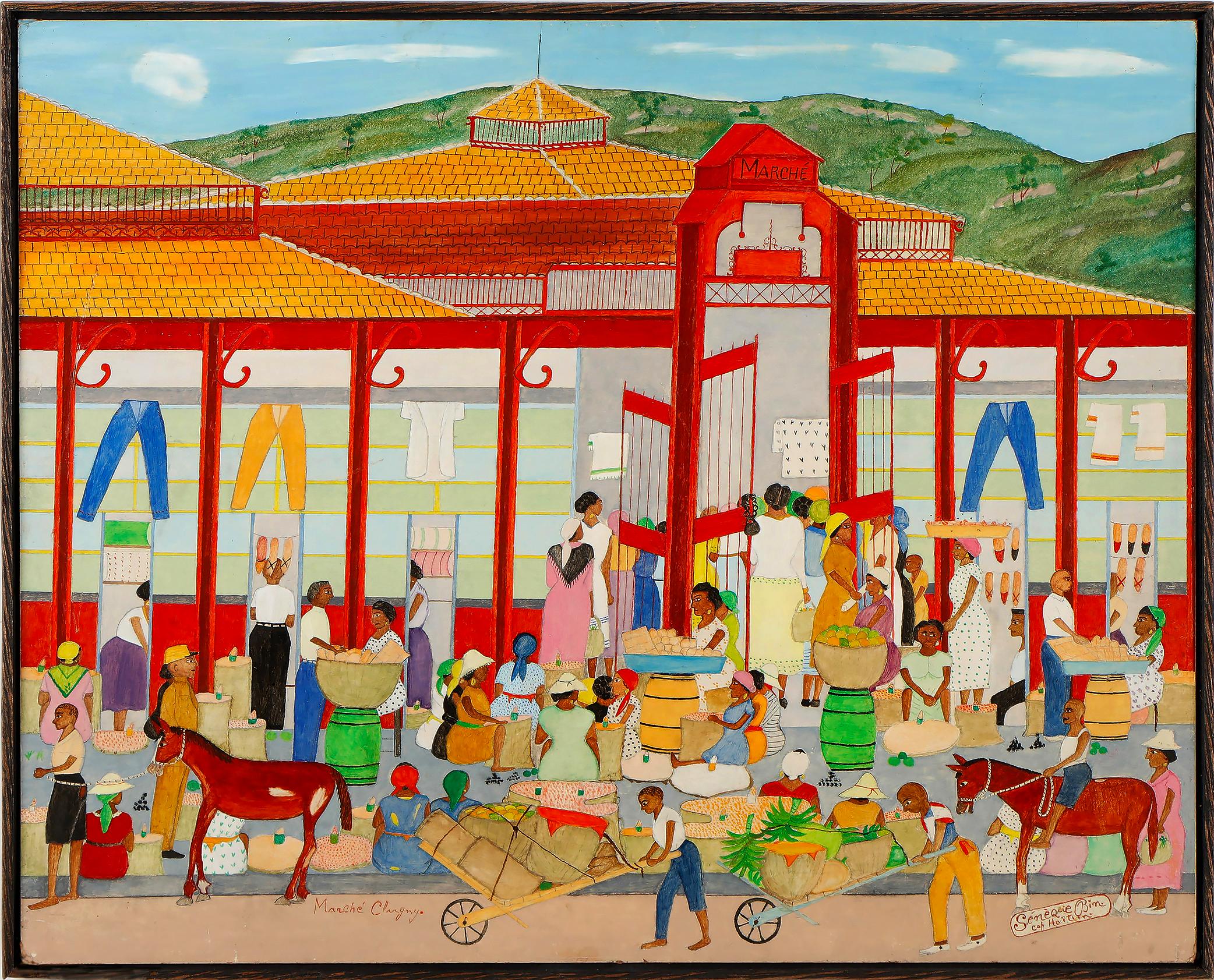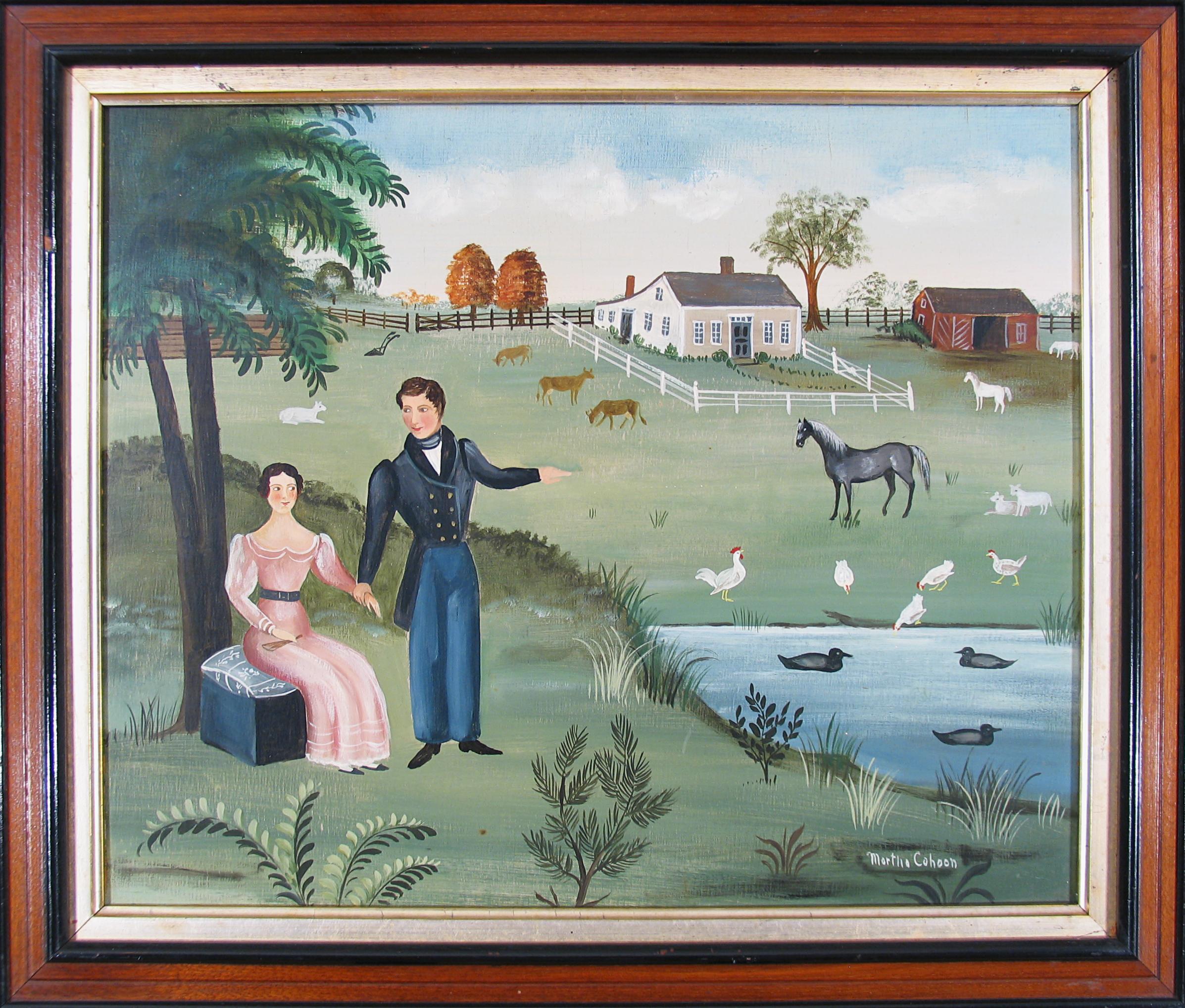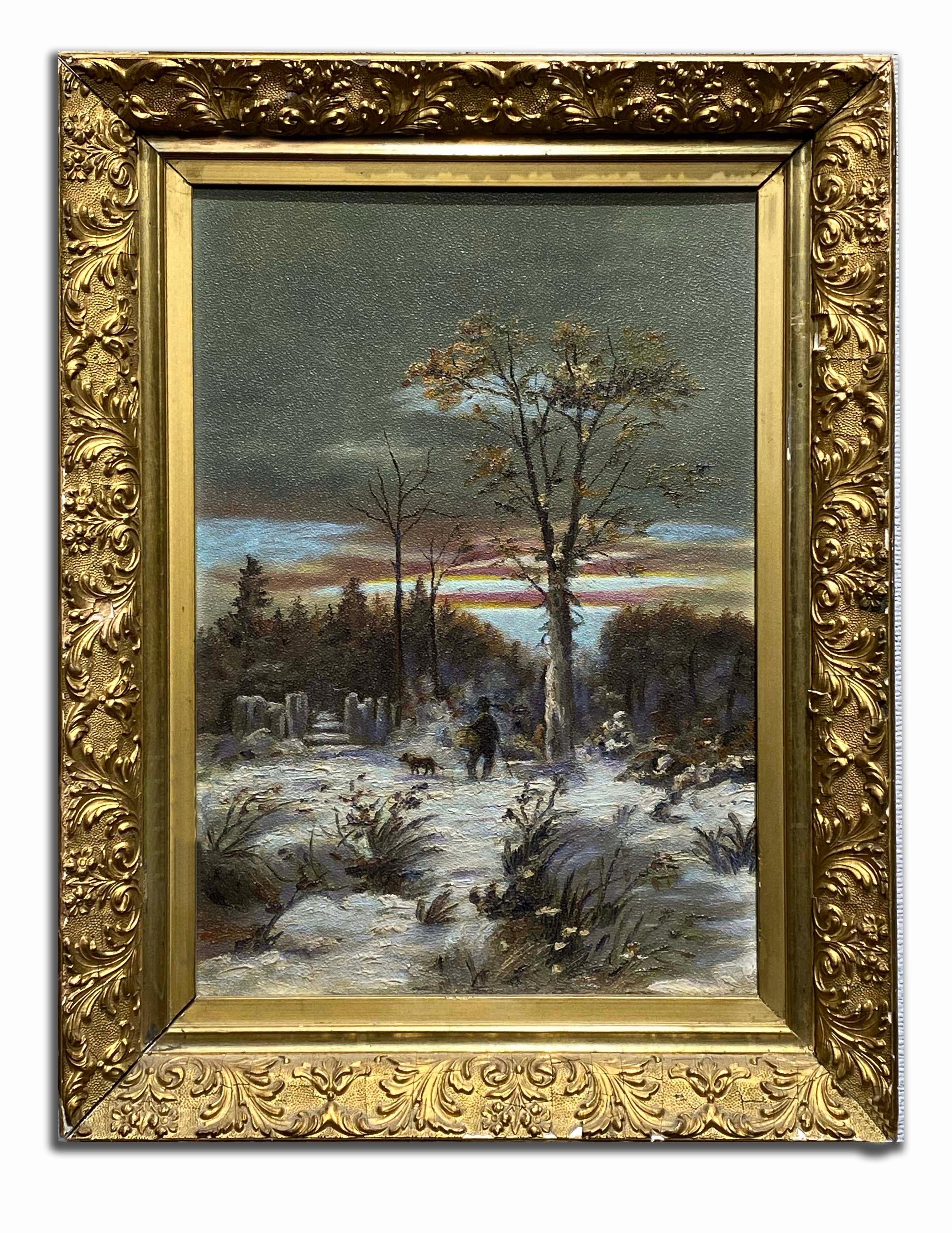Items Similar to "Neighborhood Shivaree, " Fred E. Robertson, Grandma Moses, Self-Taught Landscape
Want more images or videos?
Request additional images or videos from the seller
1 of 10
Fred E. Robertson"Neighborhood Shivaree, " Fred E. Robertson, Grandma Moses, Self-Taught Landscape1945
1945
About the Item
Fred E. Robertson (1878 - 1953)
Neighborhood Shivaree, 1945
Signed and dated lower left
Oil on masonite
16 x 20 inches
Exhibited:
Buffalo, The Buffalo Fine Arts Academy, Albright Art Gallery, Annual Exhibition at Buffalo by Artists of Western New York, March 1945.
Fred Robertson, like his more famous older sister, Anna Mary Robertson (Grandma) Moses, was born on a farm northeast of Albany, New York, and grew up in relative poverty. While attending the district school, he earned extra money as a farmhand. Without the benefit of high school, he managed, at the age of twenty-three, to enter and ultimately graduate from Cornell Agricultural College. He taught school for a time, but in 1920 he bought a 300-acre farm in Savannah, New York, producing wheat, produce, and dairy products.
Around 1943, when his two sons began helping him work the farm, he had more free time and, encouraged by his sister, Robertson tried his hand at painting. This activity, taken up as a hobby, turned into a passion, and for the rest of his life Robertson devoted many hours to art. While he had picked up some technical tips from Anna Mary–using fairly dry oil paint on boards, rather than canvas–his style differed greatly from hers. His brushstrokes were stronger and bolder, his palette more somber, his subject matter less lyrical. In his landscapes, he documented life on the farm in a matter-of-fact manner, including numerous old-time vehicles and customs. In total, he completed about two hundred paintings.
Robertson had a one-man show at Galerie St. Etienne in 1945, which generated much interest and critical success. His works later appeared in group shows in New York and nationwide.
Roberta Smith reviewed the exhibition "The Forgotten Folk Art of the 1940's," at Galerie St. Etienne: "Still, it's great to see Israel Litwak's dense little landscapes in which careful patterns make every leaf and flower stand out. Also worthy of rediscovery are the paintings of Grandma Moses' younger brother, Fred Robertson, who took up the brush after his sister's success. Sibling rivalry is clearly as effective as any other artistic motivation: at least in this context, Robertson's less meticulous, more emotional landscapes and farm scenes outshine the efforts of his famous sister."
- Creator:Fred E. Robertson
- Creation Year:1945
- Dimensions:Height: 22 in (55.88 cm)Width: 26 in (66.04 cm)
- Medium:
- Movement & Style:
- Period:
- Condition:
- Gallery Location:New York, NY
- Reference Number:1stDibs: LU1841211235102
About the Seller
5.0
Platinum Seller
These expertly vetted sellers are 1stDibs' most experienced sellers and are rated highest by our customers.
Established in 2021
1stDibs seller since 2022
60 sales on 1stDibs
Typical response time: 1 hour
- ShippingRetrieving quote...Ships From: New York, NY
- Return PolicyA return for this item may be initiated within 3 days of delivery.
More From This SellerView All
- "Swapping Horses" Fred E. Robertson, Grandma Moses, Self-Taught LandscapeLocated in New York, NYFred E. Robertson (1878 - 1953) Swapping Horses, 1947 Signed and dated lower right Oil on masonite 12 5/8 x 24 inches Fred Robertson, like his more famous older sister, Anna Mary Ro...Category
1940s Folk Art Landscape Paintings
MaterialsMasonite, Oil
- "Sensation in Wall Street, New York" Herman Hyneman, Jewish Artist, Gilded AgeBy Herman HynemanLocated in New York, NYHerman N. Hyneman (1849 - 1907) Sensation in Wall Street, New York, 1903 Oil on canvas 24 x 16 inches Signed and dated lower left Provenance: Roger King, Newport, Rhode Island Herman N. Hyneman was a noted American portrait and figure painter with ties to both Philadelphia and New York. He was born July 27,1849 to Leon and Adeline Hyneman in Philadelphia. ("Who Was Who in American Art" lists his birth date as either 1849 or 1859, but we have confirmed that the birth date is 1849). Virtually nothing is known about his early years, but given the fact that the family resided in a wealthy section of Philadelphia and the fact that he traveled to Paris to study in the studio of Leon Bonnat when he was but 20 years old, it is presumed that the family was financially comfortable if not well to do. Hyneman exhibited at the Paris Salon in 1879 and 1881, which was quite an accomplishment given his tender age. He returned to the United States in 1882 and after a year in Philadelphia, he established a studio at 58 West 57th Street, New York, NY, where he painted portraits to support himself and scenes of beautiful fair-skinned women walking in the snow to exhibit at major exhibitions throughout the United States. Hyneman exhibited at the the Brooklyn Art Association in 1882, 1883 and 1884 and at the Pennsylvania Academy of Fine Arts in 1883 and 1888. Beginning in 1882 and continuing up until 1905, he exhibited regularly at the National Academy of Design. Despite the fact that he exhibited fourteen paintings at the National Academy over a span of three different decades, he was never elected as a member. In the 1880's his paintings sold for between $100 and $1500, which were substantial sums for that period. Hyneman also exhibited at the Salmagundi Club and the Philadelphia Art Club and was a member of each organization. He won a medal at the American Art Society in 1904 and also exhibited at the Chicago Art Institute. A handwritten label on one of his paintings indicates that he also exhibited in Budapest, Hungary. In 1892, Hyneman married the noted artist Juliet Jolley (aka Jolly), who had previously modeled for him. Thereafter, they shared a studio and on at least one occasion exhibited together. The February 5, 1896 edition of the "New York Times" reported on a "pleasant studio reception" at 58 West 57th Street where the paintings of both Herman and Juliet were shown to members of New York Society including Mr. And Mrs. Edwin Blashfield. At least one of Hyneman's Painting " A Sensation on Wall Street" which depicted a lovely young woman in fur coat with Muff in front of the Stock Exchange, was made into a post card and reproductions of his paintings are known to exist, although not plentiful. At least one etching is known, "Desdemona," which was reproduced in a book by Frederic Stokes. Herman Hyneman...Category
Early 1900s American Impressionist Landscape Paintings
MaterialsCanvas, Oil
- "Elegant Lady in Winter, Trinity Church, New York" Herman Hyneman, Gilded AgeBy Herman HynemanLocated in New York, NYHerman N. Hyneman (1849 - 1907) Elegant Lady in Winter, Trinity Church, New York City Oil on canvas 22 x 15 inches Signed lower right Provenance: Freemans, 2005, Lot 76 Herman N. Hyneman was a noted American portrait and figure painter with ties to both Philadelphia and New York. He was born July 27,1849 to Leon and Adeline Hyneman in Philadelphia. ("Who Was Who in American Art" lists his birth date as either 1849 or 1859, but we have confirmed that the birth date is 1849). Virtually nothing is known about his early years, but given the fact that the family resided in a wealthy section of Philadelphia and the fact that he traveled to Paris to study in the studio of Leon Bonnat when he was but 20 years old, it is presumed that the family was financially comfortable if not well to do. Hyneman exhibited at the Paris Salon in 1879 and 1881, which was quite an accomplishment given his tender age. He returned to the United States in 1882 and after a year in Philadelphia, he established a studio at 58 West 57th Street, New York, NY, where he painted portraits to support himself and scenes of beautiful fair-skinned women walking in the snow to exhibit at major exhibitions throughout the United States. Hyneman exhibited at the the Brooklyn Art Association in 1882, 1883 and 1884 and at the Pennsylvania Academy of Fine Arts in 1883 and 1888. Beginning in 1882 and continuing up until 1905, he exhibited regularly at the National Academy of Design. Despite the fact that he exhibited fourteen paintings at the National Academy over a span of three different decades, he was never elected as a member. In the 1880's his paintings sold for between $100 and $1500, which were substantial sums for that period. Hyneman also exhibited at the Salmagundi Club and the Philadelphia Art Club and was a member of each organization. He won a medal at the American Art Society in 1904 and also exhibited at the Chicago Art Institute. A handwritten label on one of his paintings indicates that he also exhibited in Budapest, Hungary. In 1892, Hyneman married the noted artist Juliet Jolley (aka Jolly), who had previously modeled for him. Thereafter, they shared a studio and on at least one occasion exhibited together. The February 5, 1896 edition of the "New York Times" reported on a "pleasant studio reception" at 58 West 57th Street where the paintings of both Herman and Juliet were shown to members of New York Society including Mr. And Mrs. Edwin Blashfield. At least one of Hyneman's Painting " A Sensation on Wall Street" which depicted a lovely young woman in fur coat with Muff in front of the Stock Exchange, was made into a post card and reproductions of his paintings are known to exist, although not plentiful. At least one etching is known, "Desdemona," which was reproduced in a book by Frederic Stokes. Herman Hyneman...Category
Late 20th Century American Impressionist Landscape Paintings
MaterialsCanvas, Oil
- "The Green Parasol, " Henry Hannig, American Impressionist, Woman in Beach SceneBy Henry HannigLocated in New York, NYHenry Charles Hannig (1883 - 1948) The Green Parasol Oil on canvas mounted on board 6 x 7 3/4 inches Provenance: R.H. Love Galleries, Chicago, Illinois Private Collection, Lake Orion, Michigan Hannig, born in Hirschberg, Germany on 27 February 1883, came to America with his parents at the age of seven. He attended school in the southwest suburbs before the family settled in Chicago. Young Henry enrolled in the Chicago Academy of Fine Arts where Lawton Parker became his mentor. He made ends meet by working in industrial design and illustration. By 1908 he was a pupil in the School of the Art Institute of Chicago where students followed the traditional European drawing curriculum, beginning with the copying of master engravings and drawing after plaster casts, then concentrating on the nude figure. Students worked toward the goal of winning various academic prizes. One of Hannig's fellow students was Louis Ritman...Category
1910s American Impressionist Figurative Paintings
MaterialsCanvas, Oil, Board
- "Day at the Beach, " Nikol Schattenstein, Sunny Seaside Belgian Figurative SceneBy Nikol SchattensteinLocated in New York, NYNikol Schattenstein (1877 - 1954) Day at the Beach Oil on canvas 27 3/4 x 33 1/2 inches Signed lower left Provenance: Descended in the family of the artist Estate of Howard Aronso...Category
Early 20th Century Impressionist Landscape Paintings
MaterialsCanvas, Oil
- Saratoga Springs Racetrack, Summer Grandstand Crowd, Horse BettorsBy Anne DiggoryLocated in New York, NYAnne Diggory (b. 1951) Grandstand Crowd, Saratoga Springs Racecourse, New York Oil on panel 26 x 31 inches Initialed lower right: APD Anne Diggory lives ...Category
1970s Contemporary Figurative Paintings
MaterialsOil, Panel
You May Also Like
- "Cars, Buildings People" Contemporary Outsider Folk Art African American UrbanBy Purvis YoungLocated in New York, NY"Cars, Buildings People" Contemporary Outsider Folk Art African American Urban The painting measures 65 x 48 inches. We love that in the middle of ...Category
1990s Outsider Art Landscape Paintings
MaterialsMasonite, Oil
- Marché Cluny - Market at Cap-Haitien - Haitian Street ArtLocated in Miami, FLA bustling street scene of everyday life in front of the famed Marché in Cap-Haïtien is rendered in Sénèque This is a relatively early work by Obin's signature brightly colored and flat naive style. Signed lower right. Provenance: Galerie Issa - Port-Au-Prince, Haiti - Owned by Issa El Saieh of later named El Saieh Gallery Sénèque Obin...Category
1950s Outsider Art Landscape Paintings
MaterialsOil, Masonite
- Couple by Farmyard oil painting by Martha CahoonBy Martha CahoonLocated in Hudson, NYSigned "Martha Cahoon" lower right. Provenance: private collection, Palm Beach Florida About this artist: Born of Swedish immigrant parents in 1905, in Rosindale, Massachusetts, Martha Farham Cahoon had a highly successful business partnership with her husband Ralph Cahoon...Category
1960s Folk Art Figurative Paintings
MaterialsOil, Board
- Silent NightBy Fannie Lou SpelceLocated in Austin, TXArtist: Fannie Lou Spelce Title: "Silent Night" Year: 1973 Size: 16" x 20" Medium: Oil on Linen Signature: Signed & Dated LR UnframedCategory
Late 20th Century Folk Art Landscape Paintings
MaterialsOil, Linen
- Antique American Folk Art Dog Man Woods Oil Painting Original Frame Gold 19th C.Located in Buffalo, NYAn antique American folk art painting in its original period frame. Featuring a man walking his dogs in the woods with a stunning s...Category
1890s Folk Art Landscape Paintings
MaterialsOil, Board
- Ex-Voto, Retablo, Painting on Metal, Mexico , Prayer to St. George, Folk ArtLocated in Houston, TXThis retablo was purchased by the gallery in Mexico City. I knew the family that sold this retablo to me. The writing says" Puebla 1940,. It is a prayer to St. George thanking him that his dog saved him from being attached from a snake. He is is thankful that his dog was not bitten by the snake. Bernardino Pantoja This ex-voto is in excellent condition. It is framed behind conservatorship glass. The framed size is 14" x 15". The class should only be cleaned with ammonia free cleaner. An ex-voto is a votive offering to a saint or to a divinity; the term is usually restricted to Christian examples. It is given in fulfillment of a vow (hence the Latin term, short for ex voto suscepto, "from the vow made") or in gratitude or devotion. Ex-votos are placed in a church or chapel where the worshiper seeks grace or wishes to give thanks. The destinations of pilgrimages often include shrines decorated with ex-votos. Ex-votos can take a wide variety of forms. They are not only intended for the helping figure, but also as a testimony to later visitors of the received help. As such they may include texts explaining a miracle attributed to the helper, or symbols such as a painted or modeled reproduction of a miraculously healed body part, or a directly related item such as a crutch given by a person formerly lame. There are places where a very old tradition of depositing ex-votos existed, such as Abydos in ancient Egypt. Especially in the Latin world, there is a tradition of votive paintings, typically depicting a dangerous incident which the offeror survived. The votive paintings of Mexico...Category
1940s Folk Art Landscape Paintings
MaterialsMetal
Recently Viewed
View AllMore Ways To Browse
Fine Art For Less
Neighborhood Painting
Brother Sister
Agriculture Art
Western New York Vintage
Three Sisters
Neighborhood Vintage
Little Brothers
Three Sisters Art
E March
Israel Landscape Painting
Israeli Landscape Paintings
Life Of Fred Used
Old Money
Motivational Art
Old Money Style
Mary Manning
The Little Review



